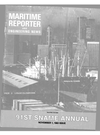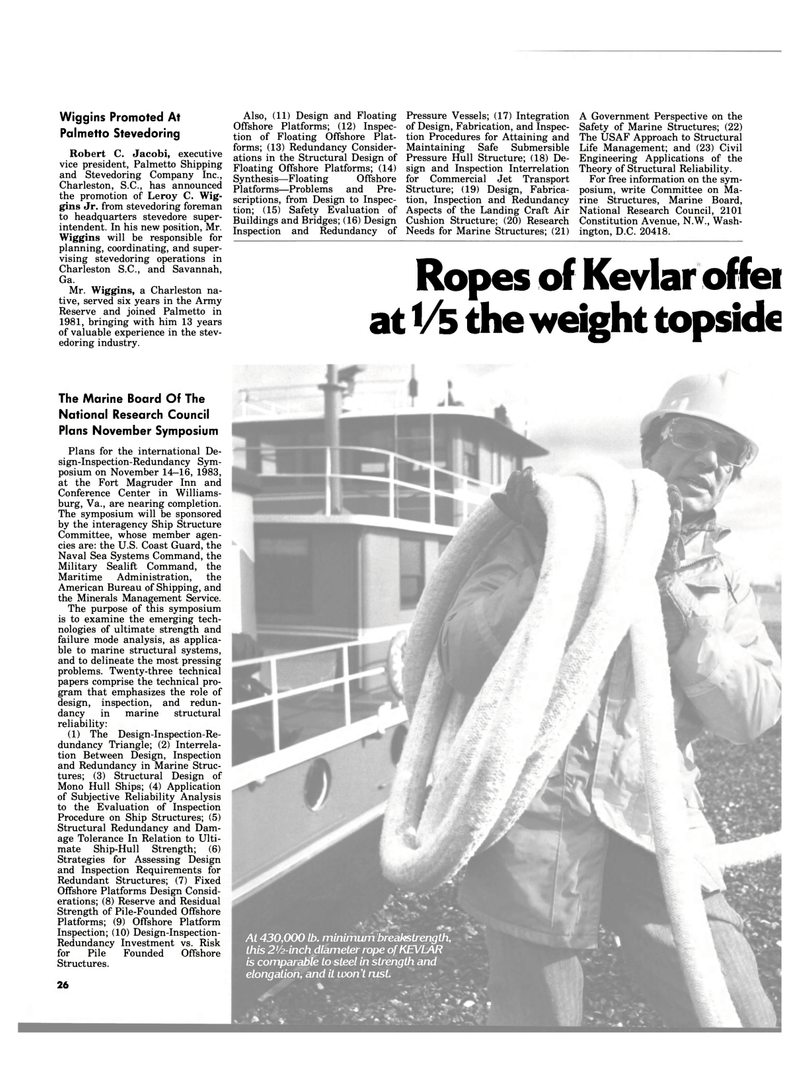
Page 28: of Maritime Reporter Magazine (November 1983)
Read this page in Pdf, Flash or Html5 edition of November 1983 Maritime Reporter Magazine
Wiggins Promoted At
Palmetto Stevedoring
Robert C. Jacobi, executive vice president, Palmetto Shipping and Stevedoring Company Inc.,
Charleston, S.C., has announced the promotion of Leroy C. Wig- gins Jr. from stevedoring foreman to headquarters stevedore super- intendent. In his new position, Mr.
Wiggins will be responsible for planning, coordinating, and super- vising stevedoring operations in
Charleston S.C., and Savannah,
Ga.
Mr. Wiggins, a Charleston na- tive, served six years in the Army
Reserve and joined Palmetto in 1981, bringing with him 13 years of valuable experience in the stev- edoring industry.
The Marine Board Of The
National Research Council
Plans November Symposium
Plans for the international De- sign-Inspection-Redundancy Sym- posium on November 14—16, 1983, at the Fort Magruder Inn and
Conference Center in Williams- burg, Va., are nearing completion.
The symposium will be sponsored by the interagency Ship Structure
Committee, whose member agen- cies are: the U.S. Coast Guard, the
Naval Sea Systems Command, the
Military Sealift Command, the
Maritime Administration, the
American Bureau of Shipping, and the Minerals Management Service.
The purpose of this symposium is to examine the emerging tech- nologies of ultimate strength and failure mode analysis, as applica- ble to marine structural systems, and to delineate the most pressing problems. Twenty-three technical papers comprise the technical pro- gram that emphasizes the role of design, inspection, and redun- dancy in marine structural reliability: (1) The Design-Inspection-Re- dundancy Triangle; (2) Interrela- tion Between Design, Inspection and Redundancy in Marine Struc- tures; (3) Structural Design of
Mono Hull Ships; (4) Application of Subjective Reliability Analysis to the Evaluation of Inspection
Procedure on Ship Structures; (5)
Structural Redundancy and Dam- age Tolerance In Relation to Ulti- mate Ship-Hull Strength; (6)
Strategies for Assessing Design and Inspection Requirements for
Redundant Structures; (7) Fixed
Offshore Platforms Design Consid- erations; (8) Reserve and Residual
Strength of Pile-Founded Offshore
Platforms; (9) Offshore Platform
Inspection; (10) Design-Inspection-
Redundancy Investment vs. Risk for Pile Founded Offshore
Structures. 26
At 430,000 lb. minimum breakstrength, this 2'/2-inch diameter rope ofKEVLAR is comparable to steel in strength and elongation, and it won't rust
Also, (11) Design and Floating
Offshore Platforms; (12) Inspec- tion of Floating Offshore Plat- forms; (13) Redundancy Consider- ations in the Structural Design of
Floating Offshore Platforms; (14)
Synthesis—Floating Offshore
Platforms—Problems and Pre- scriptions, from Design to Inspec- tion; (15) Safety Evaluation of
Buildings and Bridges; (16) Design
Inspection and Redundancy of
Pressure Vessels; (17) Integration of Design, Fabrication, and Inspec- tion Procedures for Attaining and
Maintaining Safe Submersible
Pressure Hull Structure; (18) De- sign and Inspection Interrelation for Commercial Jet Transport
Structure; (19) Design, Fabrica- tion, Inspection and Redundancy
Aspects of the Landing Craft Air
Cushion Structure; (20) Research
Needs for Marine Structures; (21)
A Government Perspective on the
Safety of Marine Structures; (22)
The USAF Approach to Structural
Life Management; and (23) Civil
Engineering Applications of the
Theory of Structural Reliability.
For free information on the sym- posium, write Committee on Ma- rine Structures, Marine Board,
National Research Council, 2101
Constitution Avenue, N.W., Wash- ington, D.C. 20418.
Ropes of Kevlar offei at Vs the weight topside

 27
27

 29
29
